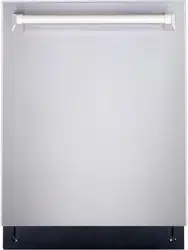Loading ...
Loading ...
Loading ...

16 17
Troubleshooting
Refer to this table to correct minor issues before calling for service.
Error codes
t
CODE MEANING POSSIBLE CAUSE
E1 Longer inlet time
• The water faucet is not opened
• Water intake is restricted
• Water pressure is too low
• Drain hose was plugged.
E4 Overflow A leak in the dishwasher
E9
A button has been touched
for more than 30 seconds (by
anything, including water).
Anything (including water) is touching a button.
CAUTION:
• If an overflow occurs, turn off the main water supply before calling for service.
• If there is water in the base pan because of an overfill or small leak, the water should be removed before restarting the dishwasher.
PROBLEM POSSIBLE CAUSE POSSIBLE SOLUTION
The dishwasher won’t start
The door may not be closed
properly.
Make sure that the door is closed and latched.
The power is off or not
connected.
Make sure that the power is connected and turned
on.
The delay start option is
selected.
Refer to the “Delay” section under "Controls and
indicators" on page 8.
The child lock is activated.
Deactivate the child lock. Refer to the “Child lock”
section under "Options" on page 9
The dishwasher beeps at the
end of the cycle
This is normal and indicates
that the wash cycle is
complete.
The rinse aid light is on The rinse aid level is low. Add rinse aid.
The dishwasher runs too long
The dishwasher is connected
to a cold water supply.
Make sure that the dishwasher is connected to a
hot water supply. If not, change the water supply to
a hot water source.
The cycle time varies,
depending on the soil level of
the dishes.
When heavy soil is detected, the wash times will be
longer.
Depends on the option
selected.
Some options will add time to the cycle.
The dishes are not clean
enough
The water pressure is too low.
Make sure that the water pressure is above 20 psi
(138 kPa). Use your dishwasher when water
demand is low.
The inlet water temperature
is too low.
Make sure that the dishwasher is connected to a
hot water supply. If not, change the water supply to
a hot water source.
Use your dishwasher when hot water demand is
low.
Dishes are too close together.
Reload the dishwasher as shown in "
Preparing and
loading dishes" on page 9.
Improper use of detergent.
Add detergent depending on the water hardness
and washing cycle you choose. Use fresh
detergent.
The selected cycle is not
suitable for the soil level on
the dishes.
Choose a different cycle with a longer washing
time.
The spray arms are blocked.
Make sure that the spray arms are not blocked and
are free to rotate.
The dishes are not drying
enough
The rinse aid dispenser is
empty or the setting is too
low.
Fill the rinse aid dispenser.
Increase the rinse aid setting.
Dishes are loaded
improperly.
Reload the dishwasher as shown in "Preparing and
loading dishes" on page 9.
The cycle you chose did not
include drying.
Choose a cycle with drying.
Spots and filming on dishes
Water hardness is too high For extremely hard water, install a water softener.
Dishes are loaded
improperly.
Reload the dishwasher as shown in "Preparing and
loading dishes" on page 9.
Old or damp rinse aid power
is used.
Use fresh, liquid rinse aid.
The rinse aid dispenser is
empty or the setting is too
low.
Fill the rinse aid dispenser.
Increase the rinse aid setting.
Etching
Using too much detergent. Use less detergent if you have soft water.
The inlet water temperature
exceeds 150° F (65.6° C).
Lower the inlet water temperature.
Detergent left in dispenser
cup
Detergent may be too old. Use fresh detergent.
The spray arm is blocked.
When you load the dishes, make sure that the spray
arms are not blocked.
The detergent dispenser will
not close
Improper operation of the
detergent cover.
Add detergent and rinse aid only as indicated in
this manual. See “Filling the detergent dispenser”
and "Filling the rinse aid dispenser" on page 11.
Water remains in the
dishwasher.
The previous cycle has not
finished or has been
interrupted.
Make sure that the current cycle is finished.
The dishwasher does not
drain properly.
The drain is clogged.
Check the air gap (if so equipped).
Make sure that the garbage disposal is empty (if so
connected).
The drain hose is kinked.
Make sure that the drain hose is not kinked and is
properly connected.
Suds in the tub Using improper detergent.
Make sure to use only automatic dishwasher
detergent.
The dishwasher leaks
Excessive suds caused by
using improper detergent.
Make sure to use only automatic dishwasher
detergent.
The dishwasher is not level.
Level the dishwasher (refer to the Installation
Manual).
There are black or gray marks
on the dishes
Aluminum utensils have
rubbed against the dishes.
Make sure that the water inlet temperature is not
less than 120° F (49° C).
The interior of the tub is
stained
Coffee or tea stains. Use a spot cleaner to remove the stains.
Reddish stain.
Some tomato products may cause this. Rinse your
dishes before loading to help prevent this.
Noises
Detergent cup opening/drain
pump.
This is normal.
A hard object has entered the
wash module. When the
object is ground up the noise
will stop.
If the noise continues after the cycle is complete,
call for service.
The dishwasher won’t fill (the
dishwasher will beep)
The water valve is turned off. Turn on the water valve.
The door may not be closed
completely.
Make sure that the door is closed and latched.
PROBLEM POSSIBLE CAUSE POSSIBLE SOLUTION
Loading ...
Loading ...
